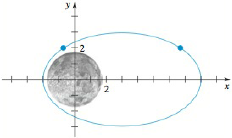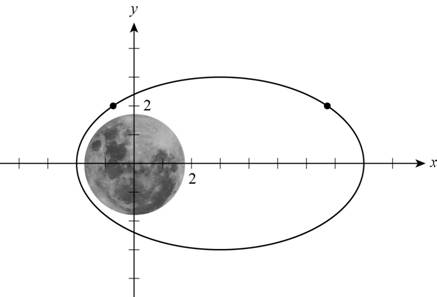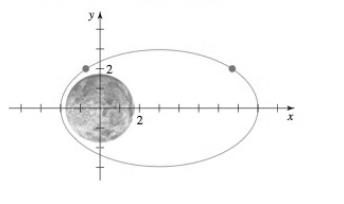
Concept explainers
Orbit of a Satellite A satellite is in orbit around the moon. A coordinate plane containing the orbit is set up with the center of the moon at the origin, as shown in the graph, with distances measured in megameters (Mm). The equation of the satellite’s orbit is
- (a) From the graph, determine the closest and the farthest that the satellite gets to the center of the moon.
- (b) There are two points in the orbit with y-coordinates 2. Find the x-coordinates of these points, and determine their distances to the center of the moon.

(a)
The closest and the farthest points that the satellite gets to the center of the moon in the graph.
Answer to Problem 115E
The closest and the farthest points that the satellite gets to the center of the moon in the graph is
Explanation of Solution
Given:
The equation of satellite’s orbit is,
And the graph of orbit with the centre of the moon at the origin is,

Figure (1)
Calculation:
The closest and farthest points in satellite’s orbit can be found by the intersection points of equation
Substitute 0 for y in orbit equation
Further solve,
So the closest and the farthest points that the satellite gets to the center of the moon in the graph is
(b)
The x-coordinates of points in the orbit with y-coordinates 2 and find their distances to the center of moon.
Answer to Problem 115E
The x-coordinates of points in the orbit with y-coordinates 2 is 7.3303 and
Explanation of Solution
Given:
The equation of satellite’s orbit is,
And the graph of orbit with the centre of the moon at the origin is,

Figure (1)
Calculation:
The x-coordinates of the points in the orbit with y-coordinates 2 is,
Further solve,
So the two value of x is
And the distance of the point
So distance of the point
And the distance of the point
So distance of the point
Chapter 1 Solutions
Precalculus: Mathematics for Calculus - 6th Edition
- If a snowball melts so that its surface area decreases at a rate of 10 cm²/min, find the rate (in cm/min) at which the diameter decreases when the diameter is 12 cm. (Round your answer to three decimal places.) cm/minarrow_forward1) let X: N R be a sequence and let Y: N+R be the squence obtained from x by di scarding the first meN terms of x in other words Y(n) = x(m+h) then X converges to L If and only is y converges to L- 11) let Xn = cos(n) where nyo prove D2-1 that lim xn = 0 by def. h→00 ii) prove that for any irrational numbers ther exsist asquence of rational numbers (xn) converg to S.arrow_forward4.2 Product and Quotient Rules 1. 9(x)=125+1 y14+2 Use the product and/or quotient rule to find the derivative of each function. a. g(x)= b. y (2x-3)(x-1) c. y== 3x-4 √xarrow_forward
- 4.2 Product and Quotient Rules 1. Use the product and/or quotient rule to find the derivative of each function. 2.5 a. g(x)=+1 y14+2 √x-1) b. y=(2x-3)(x-:arrow_forward3. The total profit (in dollars) from selling x watches is P(x)=0.52x²-0.0002x². Find and interpret the following. a) P(100) b) P'(100)arrow_forward3. Find the slope and the equation of the tangent line to the graph of the given function at the given value of x. -4 f(x)=x-x³;x=2arrow_forward
- 2. Find the equation of the tangent line to the graph of the given function at the given point. f(x)=(x+3)(2x²-6) at (1,-16)arrow_forward6. Researchers who have been studying the alarming rate at which the level of the Dead Sea has been dropping have shown that the density d (x) (in g per cm³) of the Dead Sea brine during evaporation can be estimated by the function d(x)=1.66 0.90x+0.47x², where x is the fraction of the remaining brine, 0≤x≤1. a) Estimate the density of the brine when 60% of the brine remains. b) Find and interpret the instantaneous rate of change of the density when 60% of the brine remains.arrow_forward5. If g'(5) 10 and h'(5)=-4, find f'(5) for f(x)=4g(x)-2h(x)+3.arrow_forward
- 2. Find each derivative. Write answers with positive exponents. a) Dx 9x -3 [97] b) f'(3) if f(x) = x²-5x² 8arrow_forwardA ladder 27 feet long leans against a wall and the foot of the ladder is sliding away at a constant rate of 3 feet/sec. Meanwhile, a firefighter is climbing up the ladder at a rate of 2 feet/sec. When the firefighter has climbed up 6 feet of the ladder, the ladder makes an angle of л/3 with the ground. Answer the two related rates questions below. (Hint: Use two carefully labeled similar right triangles.) (a) If h is the height of the firefighter above the ground, at the instant the angle of the ladder with the ground is л/3, find dh/dt= feet/sec. (b) If w is the horizontal distance from the firefighter to the wall, at the instant the angle of the ladder with the ground is л/3, find dw/dt= feet/sec.arrow_forwardTwo cars start moving from the same point. One travels south at 60 mi/h and the other travels west at 25 mi/h. At what rate (in mi/h) is the distance between the cars increasing four hours later? Step 1 Using the diagram of a right triangle given below, the relation between x, y, and z is z² = x²+ +12 x Step 2 We must find dz/dt. Differentiating both sides and simplifying gives us the following. 2z dz dt dx 2x. +2y dt dx dy dz x +y dt dt dt 2z dy dt × dx (x+y dt dy dtarrow_forward
 Calculus: Early TranscendentalsCalculusISBN:9781285741550Author:James StewartPublisher:Cengage Learning
Calculus: Early TranscendentalsCalculusISBN:9781285741550Author:James StewartPublisher:Cengage Learning Thomas' Calculus (14th Edition)CalculusISBN:9780134438986Author:Joel R. Hass, Christopher E. Heil, Maurice D. WeirPublisher:PEARSON
Thomas' Calculus (14th Edition)CalculusISBN:9780134438986Author:Joel R. Hass, Christopher E. Heil, Maurice D. WeirPublisher:PEARSON Calculus: Early Transcendentals (3rd Edition)CalculusISBN:9780134763644Author:William L. Briggs, Lyle Cochran, Bernard Gillett, Eric SchulzPublisher:PEARSON
Calculus: Early Transcendentals (3rd Edition)CalculusISBN:9780134763644Author:William L. Briggs, Lyle Cochran, Bernard Gillett, Eric SchulzPublisher:PEARSON Calculus: Early TranscendentalsCalculusISBN:9781319050740Author:Jon Rogawski, Colin Adams, Robert FranzosaPublisher:W. H. Freeman
Calculus: Early TranscendentalsCalculusISBN:9781319050740Author:Jon Rogawski, Colin Adams, Robert FranzosaPublisher:W. H. Freeman
 Calculus: Early Transcendental FunctionsCalculusISBN:9781337552516Author:Ron Larson, Bruce H. EdwardsPublisher:Cengage Learning
Calculus: Early Transcendental FunctionsCalculusISBN:9781337552516Author:Ron Larson, Bruce H. EdwardsPublisher:Cengage Learning





